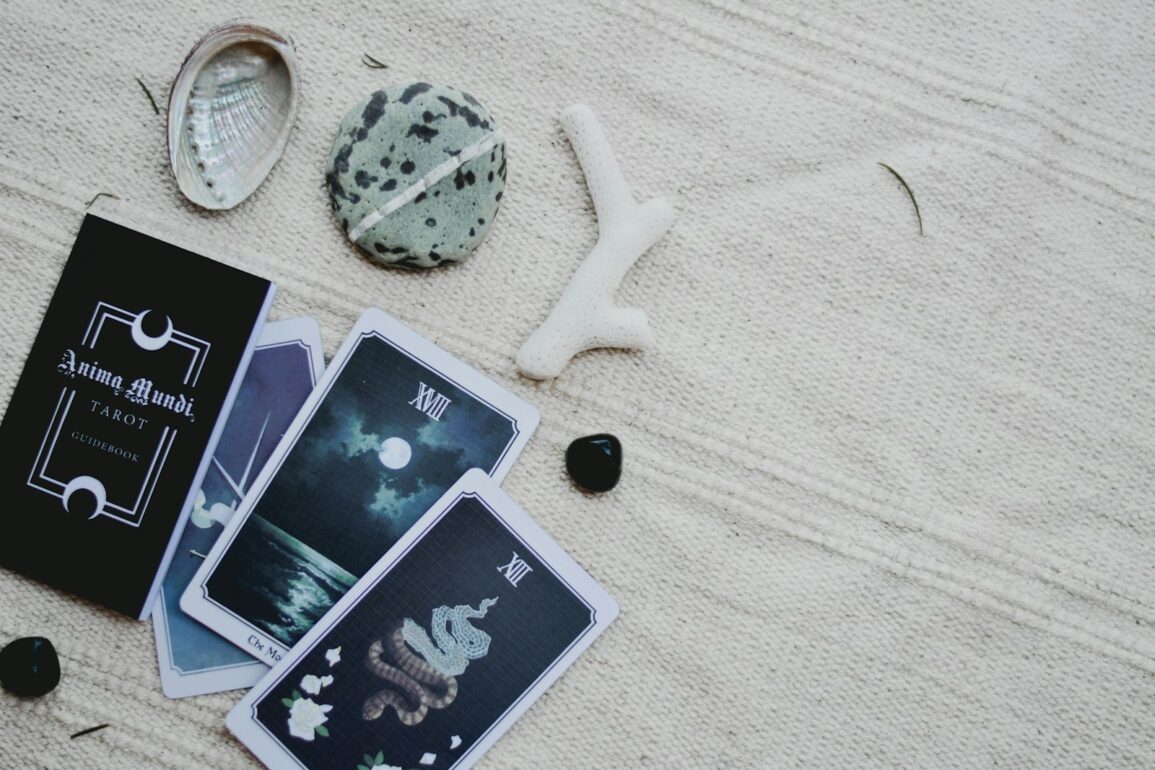When not to read Tarot cards? It’s a question that might tickle your curiosity.
Tarot cards are like intimate friends; they whisper secrets and share guidance. But timing is everything. Dive in too deep at the wrong moment, and you might just swim in circles.
I’m Laura Petit, an evolutionary astrologer and palmist with years of experience in the mystical dance of tarot readings.
Join me as we explore the when-nots of Tarot, ensuring every card you turn over serves its true purpose.
And, if you’re curious about the art of decoding the unknown in the realm of feelings and emotions, be sure to check out our article about the secret meaning of tarot cards in love (the full deck unveiled).
Key Takeaways: When should you avoid reading Tarot cards?
You should steer clear of Tarot when your emotions are as high as a kite or as low as a valley. Be wary of moments when you’re tempted to let the cards dictate life-changing choices. These red flags signal a time to pause and reflect.
1. The Emotional Rollercoaster: Why Highs and Lows Cloud Tarot Clarity
Have you ever tried to read Tarot cards while riding an emotional rollercoaster? It’s like trying to read a book during a bumpy ride.
Extreme emotions, be it joy or despair, can fog up the lens you view your cards through. I’ve seen it firsthand—how a heartbreak or a promotion can warp the wisdom of the cards.
Before you shuffle that deck, find your center, take a breath, and let the emotional dust settle.
Tip: Keep a journal handy. When emotions surge, pen them down before you lay down a single card.
2. Decision Paralysis: Tarot Isn’t a Magic 8-Ball
We’ve all been there, standing at life’s crossroads, wishing for a sign. And while Tarot cards are powerful tools, they’re not shortcuts to decision-making.
I remember a client who almost turned her back on a dream job, all because of a few upside-down cards. Tarot is a guide, not a commander. Use it to reflect, not to dictate your life’s script.
Tip: Pair each reading with a good old pros and cons list. It’ll give you clarity without the cards calling all the shots.
You may like: The Fool card and its 7 nuggets on feelings and romance you need to know about
3. The Skeptic’s Shuffle: When Doubt Dominates the Deck
Here’s another key moment to avoid reading Tarot cards. Ever tried to read Tarot amidst a cloud of skepticism? It’s like trying to catch a tune with earplugs in.
Doubt can be a deck’s worst enemy, leading you to dismiss or misinterpret the cards’ messages. When I read for skeptics, the cards often reflect their disbelief, not the insight they seek.
So, if you’re feeling skeptical, take a step back. Tarot’s wisdom shines brightest when you’re open to the conversation.
Tip: Breathe in curiosity before you shuffle; it’s the antidote to doubt.
You may like: 8 must-know facts before you trust the tarot’s tale: can they really tell the truth? (or predict the future?)
4. The Fresh Deck Dilemma: New Cards, New Confusions
A new Tarot deck is like a stranger; it takes time to get to know each other. Rushing into readings can lead to a tangle of confusion.
I’ve seen it happen—a fresh deck giving off vibes that seem off-kilter. Why? Because each deck has its own energy, and it’s crucial to bond with it first. Let your new deck introduce itself, card by card.
Tip: Sleep with your new deck under your pillow for a week. It’s an old trick to sync your energies.
5. When Curiosity Caves to Peer Pressure
Group Tarot sessions might sound like fun, but they can turn into a game of telephone. The intimacy of a personal reading often gets lost in the chorus of voices.
Plus, the pressure to conform or impress can skew the reading’s authenticity. I’ve found that the most profound insights come from one-on-one sessions, where the focus is solely on you and the cards.
Tip: For the truest reading, seek solitude. Let the cards speak to you, not the crowd.
6. The Copycat Quandary: Imitation Isn’t the Sincerest Form of Tarot
Ever caught yourself mirroring another reader’s Tarot style? It’s a trap! Each reader’s flair is as unique as their fingerprint.
Copying can lead you down a confusing path, away from your own intuitive gifts. I learned this the hard way, trying to mimic a mentor’s methods. It just didn’t click until I embraced my own style.
Remember, Tarot is a personal journey. Your readings should be as individual as you are.
Tip: Trust your instincts; they’re your personal Tarot compass.
You may like: The Financial Tarot Spread: Unlock Your Money Manifestation Potential (How It Works)
7. When Too Much Tarot Turns Toxic
Tarot can be addictive, I get it. But leaning on the cards for every decision? That’s when the magic turns murky.
I’ve seen folks get hooked, drawing cards for every little life hiccup. It’s a dangerous game, one that can lead you away from trusting your own gut.
Use Tarot as a tool, not a crutch. Keep your readings meaningful by setting limits—once a week, not once an hour.
Tip: Schedule your Tarot time. It’ll help you keep a healthy balance.
8. The Misinterpretation Minefield
Thinking every Tarot card is a literal sign can lead you down a rabbit hole. These cards are symbolic, like a language of the subconscious.
I remember a friend who took The Tower as a sign of impending doom. Turns out, it was just a nudge towards a much-needed change.
Look beyond the surface. Let the imagery and symbolism guide you to deeper meanings, not just the obvious ones.
Tip: Flip the script. See each card as a metaphor, not a memo.
Then comes another topical moment to avoid reading tarot cards.
9. The Echo Chamber Effect
Your reading spot matters more than you think. Ever noticed how a noisy café can turn a clear thought into a tangled mess? It’s like that with Tarot.
Your environment can echo back, coloring your readings with its own vibes. That’s why I always find a quiet corner, where the only voice I hear is the one in the cards.
A neutral space keeps your intuition pure and your insights sharp.
Tip: Create a Tarot haven, a spot where the world’s buzz can’t reach you.
You may like: A 6-Card Tarot Spread for Unlocking Your Inner Wisdom and Intuition (How It Works)
10. The Crossroads of Criticism: When You’re Too Close to the Querent
Reading Tarot for a friend or family can be like walking a tightrope without a net. You know them well, maybe too well, and that familiarity can cloud your objectivity.
It’s tough, but you’ve got to wear a blindfold of impartiality. Once, I read for my sister and had to consciously set aside what I hoped for her.
Remember, it’s about what the cards say, not what you or they want to hear.
Tip: Pretend you’re reading for a stranger. It’ll help you keep a clear head.
Conclusion
We’ve journeyed through the seven moments when not to read Tarot cards, from emotional whirlwinds to the pitfalls of familiarity.
Remember, Tarot is a tool for insight, not a one-stop-shop for life’s answers. Approach each reading with mindfulness and intention, and you’ll find the clarity you seek.
I hope you’ve enjoyed our exploration and feel more equipped to navigate the Tarot’s waters. If you’ve got stories or experiences to share, I’d love to hear them. Drop a comment and let’s keep the conversation flowing.
FAQs
When should I not read tarot?
Avoid tarot readings when emotions run high or decisions loom large. Times of skepticism or after joining a psychic fair may cloud your judgment. When the tarot deck feels unfamiliar or your environment is distracting, it’s wise to wait for clarity before consulting the cards.
What not to do with tarot cards?
Don’t rely solely on tarot cards for major life choices or let peer pressure guide your readings. Avoid reading reversed cards or upright cards without understanding their meanings. Steer clear of daily card pulls that become obsessive rather than insightful.
What are the cons of tarot cards?
The cons of tarot cards include the potential for overreliance, leading to decision paralysis. Misinterpretation, especially of individual cards or adjacent cards in a spread, can cause confusion. Without proper grounding, readings can reflect fear rather than guidance.
Can everyone read tarot cards?
Yes, everyone can read tarot cards, but it takes practice to understand card meanings and card spreads effectively. Some may consult a professional reader or attend a tarot workshop at a psychic fair to enhance their skills. It’s about intuition, not expertise.




